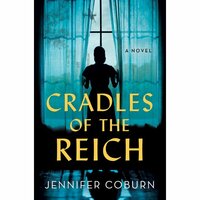Take a photo of a barcode or cover
A solid 4 star read that fans of WWII historical fiction would enjoy. Told through three different female perspectives, this story centers on the Lebensborn Society maternity homes. It was here that “racially” pure babies were delivered and, if born out of wedlock, were adopted into more “suitable” homes. Certainly a haunting historical topic, but I enjoyed reading about these three women and their different experiences and roles within the ward.
Happy Pub Day/Pub Day Review!
Cradles of the Reich is about three woman (Gundi, Irma, and Hilde) living in Heim Hochland, part of the Reich’s maternity home program. They each have different thoughts about the Nazi regime.
What I liked: The story is engaging and horrifying. There were a few times, I had to stop and think how does a society get to this point. You could understand how Gundi and Irma (to some extent) felt like one person couldn’t change anything.
I’d love a book on Gundi’s resistance work. Her chapters were by far my favorite and she’s easily the most likable character.
Hilde is written as a Nazi sympathizer who at times seems to have a conscience but then acts in whatever way will gain her more party clout and attention. She’s a hard character to like and I enjoyed her chapters the least. But because of her war work, she’s able to provide insight to the other characters about what the Nazi’s are doing.
What didn’t work for me: I wish there was a bit more closure at the end; it feels a bit abrupt. Perhaps a signal that there will be a book two?
Irma’s character arc needed more time to develop. I also felt like for someone in their mid-forties she came across very naive.
Who should read it: historical fiction fans, especially if you’re interested in life in WW2 Germany.
Thank you sourcebook for my gifted copy.
Cradles of the Reich is about three woman (Gundi, Irma, and Hilde) living in Heim Hochland, part of the Reich’s maternity home program. They each have different thoughts about the Nazi regime.
What I liked: The story is engaging and horrifying. There were a few times, I had to stop and think how does a society get to this point. You could understand how Gundi and Irma (to some extent) felt like one person couldn’t change anything.
I’d love a book on Gundi’s resistance work. Her chapters were by far my favorite and she’s easily the most likable character.
Hilde is written as a Nazi sympathizer who at times seems to have a conscience but then acts in whatever way will gain her more party clout and attention. She’s a hard character to like and I enjoyed her chapters the least. But because of her war work, she’s able to provide insight to the other characters about what the Nazi’s are doing.
What didn’t work for me: I wish there was a bit more closure at the end; it feels a bit abrupt. Perhaps a signal that there will be a book two?
Irma’s character arc needed more time to develop. I also felt like for someone in their mid-forties she came across very naive.
Who should read it: historical fiction fans, especially if you’re interested in life in WW2 Germany.
Thank you sourcebook for my gifted copy.
3 women meet at Heim Hochland, a German home for pregnant women during WWII. Told from all three POVs, each woman’s reasons for being at the home are different, yet they all become tied together during this tragic period of history.
I had never read anything about the German women who were meant to populate the Aryan race, by having “perfect” German babies. My heart was sick while I was reading about the babies who were stolen and taken from their families and then adopted out to Germans. Irma, the nurse, and Gundi, the young mother were my two favorite characters, and I had empathy for them and their date throughout the story. While Hilde was not my favorite character, I feel she was needed for this story to show how many German women during this time wanted to have genetically perfect children to be important.
The authors note was perfect. It wrapped up the story perfectly for me, and I learned so much more about “behind the scenes” of this novel.
Thank you to the publisher and author for my gifted copy.
I had never read anything about the German women who were meant to populate the Aryan race, by having “perfect” German babies. My heart was sick while I was reading about the babies who were stolen and taken from their families and then adopted out to Germans. Irma, the nurse, and Gundi, the young mother were my two favorite characters, and I had empathy for them and their date throughout the story. While Hilde was not my favorite character, I feel she was needed for this story to show how many German women during this time wanted to have genetically perfect children to be important.
The authors note was perfect. It wrapped up the story perfectly for me, and I learned so much more about “behind the scenes” of this novel.
Thank you to the publisher and author for my gifted copy.
I’m amazed that I continue to learn about new things from WWII/Holocaust. I had no idea about the Lebensborn societies. This was a very intriguing historical fiction read, I was glued from the beginning to the end. Each woman was so different from each other, but yet was living among each other in the same place. It was tough to put down this book! I enjoyed the author’s note explaining some facts behind the writing of this book. I would recommend this read! Thank you to NetGalley and Sourcebooks Landmark for the ARC. All opinions are my own.
A unique historical fiction that had a very interesting premise, but sadly fell short of my expectations.
Synopsis -
We follow three young women - Gundi a student in Berlin and currently pregnant, Hilde, a firm believer of the Nazi principles, enthusiastic to do anything for the Fatherland & Irma, a middle aged nurse who is looking for a fresh start. It is in Heim Hochland, at the Lebensborn society of maternity - the Nazi breeding home that these women will meet to change the course of their lives.
Review -
Initially the three different POVs worked very well providing insights into these women's backgrounds and the circumstances that lead them to Lebensborn.
I really appreciate the author's efforts to spotlight a lesser known part of the Nazi regime. The very idea that this kind of a highly organized breeding program existed and managed to produce thousands of children that they considered "racially fit" makes us shudder with repulsive shock. Some of the information was just so unfathomable and gave me goosebumps.
The author deserves credit for all the research surrounding this and has managed to create a great storyline around it.
However, it is the writing that didn't work for me. It felt dull at times with unnecessary details and even some cringe-worthy wordings.
While there was a lot of focus of Gundi, I felt the other two women weren't getting enough attention. Also, Hilde's thread seem to go nowhere and Irma's concluded a little too conveniently. I was also unable to really connect with any of them and that's very important for me with historical fiction.
The ending was underwhelming and so many questions remained unanswered. As I mentioned, it could've been so much better, but unfortunately lost it's direction & momentum.
Thanks Netgalley & Source books Landmark for the ARC in exchange of an honest review!
Cradles of the Reich adds a largely unexplored topic to the list of WWII historical fiction titles. Coburn takes a deep dive into the Lebensborn Society, a horrific eugenics-based breeding program.
The tales unfold through the voices of three women, one devoted to Nazi ideology, one a nurse at the Lebensborn Society home, and the third an unwilling resident. I liked this approach, but the characters needed to be more developed. Each was so extreme in their characterization with little to no complexity or internal conflict. Irma was the best-developed of the three. Hilda was almost cartoonish in her behavior and made a melodramatic villain. There were few surprises in the plot, and the ending was as expected, except I didn't feel any closure with Hilda.
I liked that the stories unfolded linearly, and the author did not use a dual timeline crutch to pad the narrative (can you tell I'm tired of dual timeline historical fiction tropes?).
I recommend this book to fans of WWII historical fiction as it tells a new story. I hope the author continues to write historical fiction because I expect she will get better and better.
Thanks to NetGalley for an electronic ARC in exchange for a review.
The tales unfold through the voices of three women, one devoted to Nazi ideology, one a nurse at the Lebensborn Society home, and the third an unwilling resident. I liked this approach, but the characters needed to be more developed. Each was so extreme in their characterization with little to no complexity or internal conflict. Irma was the best-developed of the three. Hilda was almost cartoonish in her behavior and made a melodramatic villain. There were few surprises in the plot, and the ending was as expected, except I didn't feel any closure with Hilda.
I liked that the stories unfolded linearly, and the author did not use a dual timeline crutch to pad the narrative (can you tell I'm tired of dual timeline historical fiction tropes?).
I recommend this book to fans of WWII historical fiction as it tells a new story. I hope the author continues to write historical fiction because I expect she will get better and better.
Thanks to NetGalley for an electronic ARC in exchange for a review.
informative
reflective
sad
medium-paced
Plot or Character Driven:
A mix
Strong character development:
Complicated
Loveable characters:
Complicated
Diverse cast of characters:
Yes
Flaws of characters a main focus:
Complicated
Cradles of the Reich is an excellent read for lovers of historical fiction. Jennifer Coburn does a wonderful job of drawing you into the story of thre young women who are sent to Lebensborn a German breeding program during World War II. The three women who all arrive for different reasons begin to rely on each other. I love it when a book teaches me something I did not know about and Cradles of the Reich did just that.
dark
informative
tense
fast-paced
Plot or Character Driven:
A mix
Strong character development:
Yes
Loveable characters:
Complicated
Diverse cast of characters:
Yes
Flaws of characters a main focus:
Complicated





